Understanding the Different Types of Cards in a Deck
When delving into the world of card games, it’s essential to start by understanding the basics of the deck itself. For both beginners and seasoned card enthusiasts, knowing the distinct types of cards in a standard deck is fundamental for gameplay, strategy, and appreciation of the rich history intertwined with these timeless games. Below, we’ll explore the various types of cards that you can expect to find in a traditional deck.
The Suits of a Card Deck
The standard deck of playing cards is divided into four suits, each symbolizing different elements and having its own hierarchy of cards. Let’s take a closer look:
Hearts
Heart cards are often associated with love and spring. They are colored red, making them one of the two red suits in a standard deck.
Diamonds
Like Hearts, Diamonds are also red in color. This suit is believed to represent wealth or the merchant class.
Clubs
The Clubs, depicted by a three-leaf clover shape, are black. They are said to symbolize fall and the peasant class.
Spades
Spades, with their pointed leaf-like design, are the second black suit. Historically, they pertain to winter and nobility or the warrior class.
The Ranks of Cards within the Suits
Within each suit, there are 13 cards ranging from a number 2 card through 10, and including three face cards and an Ace. Below is a breakdown of the card ranks:
- Aces – Often considered the highest value or lowest depending on the game.
- Numbers 2 through 10 – These are known as “pip” cards.
- Jack – The lowest face card, often representing a knight or a hero figure.
- Queen – The middle face card, signifying grace and power.
- King – The highest-ranking face card, indicative of authority.
Special Types of Cards in a Deck
Apart from the standard suits and rankings, there are a couple of special cards that may come with a deck:
- The Joker: Usually, two Jokers are included, which serve as wild or trump cards in certain games.
- Add-Ons: Some decks also contain additional informational or advertising cards that are not used in gameplay.
Deck Variations and Game-Specific Cards
It’s worth noting that while we’ve covered the standard Anglo-American version of a 52-card deck, there are variations used in other countries and for different games. For example:
| Deck Type | Description | Common Use |
|---|---|---|
| Tarot Deck | Includes a fifth suit of trumps or ‘Major Arcana’ cards. | Tarot Readings/Game of Tarot |
| Pinochle Deck | 48-cards with two copies of each rank in two suits. | Double-deck Pinochle |
| Skat Deck | A 32-card deck used in the game of Skat. | Traditional German card games |
Understanding different types of cards in a deck is key to grasping gameplay, building strategies, and enjoying card games to their fullest. Whether you’re shuffling for a simple game of Solitaire or angling for victory in Bridge, knowledge of your deck lays the groundwork for becoming a keen player.
The Role of Card Material and Design
In addition to the types and ranks of cards, the material and design of a deck can play a significant role in the enjoyment of card games. Typically, most playing cards are made of paper with a plastic coating to ensure durability and a smooth surface that is easy to shuffle. However, luxury decks may be crafted from plastic, wood, or even metal for a more premium feel.
| Card Material | Features | Typical Usage |
|---|---|---|
| Paper | Coated with a plastic layer for protection, affordable and common. | Everyday gameplay and casinos. |
| Plastic | Water-resistant, durable, and more expensive. | Professional card playing, outdoor use. |
| Luxury (Wood, Metal) | High-quality, unique, often collectible. | Special occasions, collectors, and gifts. |
Design Aesthetics and Custom Decks
Design wise, the back of each card may have intricate patterns or company logos, appealing to collectors and hobbyists who seek limited edition sets. Custom decks may alter traditional designs to create themed experiences, like fantasy decks or sets inspired by popular culture.
- Standard – These decks feature the classic designs we’re all familiar with.
- Collector’s Editions – Often include unique artwork and finishes.
- Themed – These may represent characters from movies, TV shows, or video games.
- Promotional – Often produced as a marketing tool with brand-specific designs.
The Impact of Card Decks on Culture and Society
The common deck of cards has played an influential role in society, not just as a source of entertainment but also as cultural artifacts reflecting history, art, and social dynamics. They have been symbols in literature and film, and their design evolution mirrors changes in social attitudes and technology.
- Cards as Cultural Icons – Appearing in countless stories and movies.
- Heraldry and Art – Royal face cards often resemble historical or mythical figures.
- Social Reflections – Changes in design can indicate shifts in societal values.
Conclusion
In conclusion, the extraordinary diversity of card decks goes far beyond numbers and suits. It encompasses variations in materials, design aesthetics, cultural significance, and historical evolution. Besides understanding the functional aspects of different cards within a deck, appreciating these multifaceted elements can enrich the experience of card playing and collecting. With every shuffle, cut, and deal, players engage with centuries of tradition and culture. Whether you are a casual player, a magician, a collector, or a historian, the world of playing cards offers a rich tapestry to explore and enjoy.
Armed with a deeper knowledge of the types of cards and their various aspects, enthusiasts can fully immerse themselves in the world of card games, anticipating every turn of a card with a newfound appreciation for its design and place within the broader context of gaming and history.



